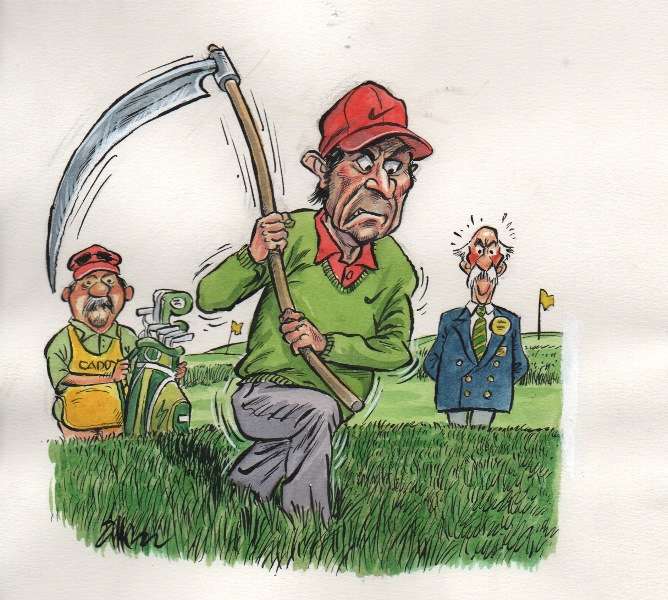Features
Huggan column: Thank God US Open is just once a year

There are a few things about golf that I have never fully understood and probably never will. Some examples: Why a drive hit out of bounds means we have to play “three off the tee”, the penalty “stroke and distance”, yet an air-shot – surely the worst crime in the game – means only “stroke” is added to the score. Trackman. Coefficient of restitution. That funny-looking, one-eyed thing some pros now do when lining up putts. Why so many professional golfers have to ask their caddies for the direction of the wind before hitting a shot. I could go on. There really is so much that I just don’t get.
To that list we must add the United States Golf Association’s obsession with both penal golf and the concept of ‘par’. Look at some of the stuff we witnessed at Oakmont last week. All that hacking, slashing, gouging an chopping was the direct result of a misguided notion that says par – an abstract figure that exists only on a scorecard – must be “protected”.
An admission at this point: I’m a ‘strategy’ guy when it comes to the design and set-up of golf courses, both for amateurs and professionals. But especially professionals. As we saw only too clearly at Oakmont during the 72 holes of torture inflicted on the 156-man field, one of the most noticeable consequences of growing long, thick rough close to narrow strips of cut grass – also known as fairways – is the complete elimination of top-level golf’s most exciting aspect: the risky recovery shot.
At Oakmont there was no chance for even the most accomplished fairway-misser to do anything other than chip the ball back into play. Why, one wonders, would anyone want to watch such a thing?
Why is reducing everyone to the same pitiful level a spectator sport? Shouldn’t the better player have a chance to separate himself from the less-gifted by dint of his superior skill?
There is a blindingly obvious arrogance in evidence here. Why does a faceless committee made up of handicap golfers think that they know more than the likes of Rory McIlroy, Jordan Spieth and Jason Day about how to play golf at the highest level? Does that make any sense?
Think about it. Here we had one of the world’s best courses being played by all of the world’s best players and a group of people in blue blazers is telling them how to plot their way round? Ridiculous. And one-dimensional. And boring.
At this point in this annual debate, my mind always goes to the Old Course at St Andrews. Golf at its best is a multi-dimensional game, much more than a mere test of execution time after time after tedious time. And that best is epitomised by the most famous 18 holes in the game.
Because there is so little long grass at the Home of Golf – although there does seem to be a disturbing trend towards growing rough on the historic Old Course – the player is offered many options about how to play each hole. At Oakmont, the route from tee-shot to holing out was pre-set; at St Andrews it changes with the weather and the positions of the pins on the enormous greens.
Imagine that the best angle into a par-four green is from the far-left side of the vast fairway. But, one day later, when the pin has been moved, say, 20-feet or so, the ideal position for the tee-shot on that same hole might be as much as 90 yards from where it was the previous day. At St Andrews you have options; at Oakmont, while the ideal driving areas might well have been different day to day, the opportunity for the players to find them was non-existent. Those spots were invariably covered in long grass. Now, does that make any sense?
The biggest tragedy, however, is that Oakmont would be the best – and certainly the most interesting – course in the States with no rough. None. Imagine how much fun we all could have had watching the players figure out the best way (for them) to play each hole. Instead of the single-file death march that we witnessed, we would have been treated to the golfing equivalent of a crowd leaving a football ground before making off in every direction.
Perhaps the most egregious aspect of Oakmont’s ninth US Open, however, is that the course we saw is so different from that originally designed by Henry and William Fownes. Yes, the greens were in the same places (although the same cannot be said for the tees that have moved back to points in the middle distance). And yes, the bunkers had not been moved. Not physically anyway. But those sand-filled hazards had shifted in relation to the edge of the fairways. Where once the short grass ended just outside the bunkers, last week it began inside them. The result? One of the first signs that a course design has been compromised: The bunkers were in the rough, the only route into the sand through the air. What a joke.
Yet again, of course, the reason for all of this nonsense is the USGA’s seeming inability to cope with the notion that the most accomplished practitioners in golf should be allowed to make one or two birdies or, heaven forbid, finish the week in red figures. Hence the introduction of such abominations as the almost 300-yard par three and a course that was as difficult as Chinese arithmetic.
The ‘proud’ boasts are that the US Open is the “toughest test in the game” and that it is the “hardest” Major to win. What madness! The person or persons who first decided ‘difficult’ is more desirable than ‘interesting’ in championship golf were misguided fools. And those who perpetuate that warped philosophy are no better. Thank goodness the US Open rears its ugly head only once a year.
Tagged US Open








